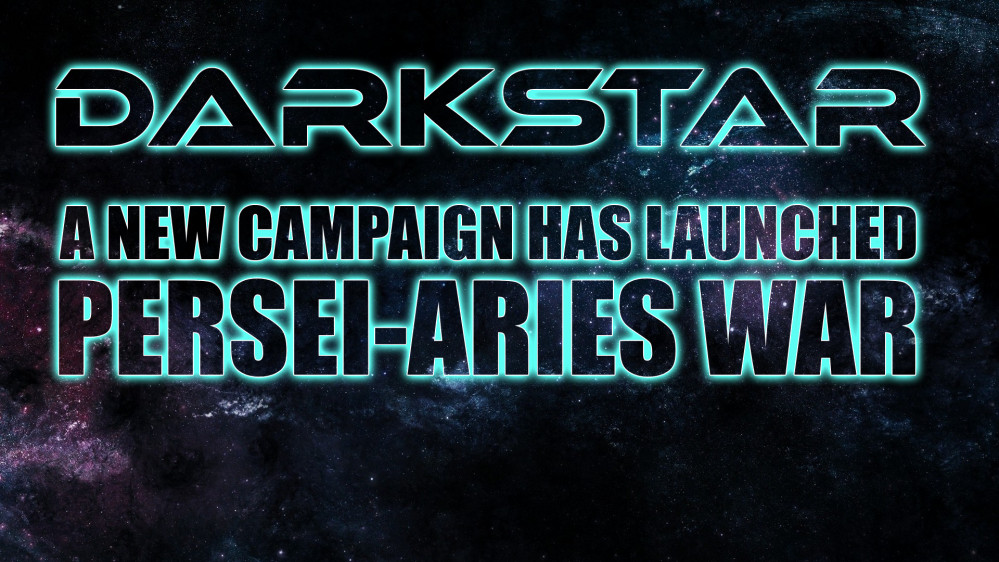
Persei-Aries War Resumes
New Romans fight their first engagement in Hercules Rim
FROM: UNITED NATIONS REGIONAL COLONIAL CENTER
14:40 SOL GMT, 29 JANUARY 2522
BREAKAUTH: 181072.18J
CLEARANCE: SECRET (NATIONAL)
NEW ROMAN RAID ON LEWIS HILL (Outer Hebrides – Mu Hercules 12.1 Delta)
The political upheaval seen across the Hercules Rim in recent months took another turn with yet another engagement. The setting for the skirmish was an old one, the long-embattled outer orbital zones of the Outer Hebrides colonies (Mu Hercules system) of the United Kingdom. What was decidedly less familiar were the combatants. Mounting the “fast strike” into the system was a task force of the newly-belligerent New Roman Alliance, having recently entered the war from their Catania colonies (Gleise 623 system). Yet it wasn’t a British force that sortied to fend off the Roman aggressors, but the Liberty task force of the United States Navy.
Former enemies in the Third Hercules War, the United States and Great Britain have more or less buried the hatchet (at least in some Hercules star systems) with the recent Treaty of Zubrin. Although overwhelmingly favorable to the British, the treaty granted the Americans shipping access through the Hercules Rim and a lease on a small base . . . allowing them to save face while backing out of the war with Great Britain. Also within that treaty, however, is a “mutual military assistance clause” requiring the two navies to come to each others’ aid if their holdings in the Hercules Rim are attacked. Clearly this clause also heavily favors the British, given that they administer two compete star systems and multiple colonies in the UN “Redemption” mandate, while the Americans only have the tiny “Lost Dutchman” planetoid awarded them in the Treaty of Zubrin.
In fact, this is the raid that first calls that mutual military assistance clause into effect. As the New Roman task force, under the flag of Commander Antonio Faccia aboard the Aurelius class heavy cruiser NRS Nicaea, enters the outer orbital zones of the Mu Hercules system, they are met by the US Navy’s Liberty carrier task force under the flag of Captain Zachary Irons. Sailing beside the American carrier is the new San Antonio class light cruiser USS Northampton, under the command of the newly-promoted captain Jack Morrison (formerly of Task Force Oriskany). Most the New Roman force is in fact French, made up of the Lerclerc Battle Group under the flag of Captain Raphael deChalemonde, supported by the Cignis Corporation frigate CMS Arauz.
Now the two fleets vector toward each other, the Americans warned of the Roman approach by a timely report of a Griffon-class gunboat. Dropping out of their short “approach waves” back into sublight speeds, they close to engagement range at the lonely outer rim planetoid of Lewis Hill (Mu Hercules 12.1 Delta). As bizarre as it seems, the Americans stand ready to defend the territory of their old enemies against a new foe, and the Battle of Lewis Hill is on.
RAID VICTORY CONDITIONS (454 points)
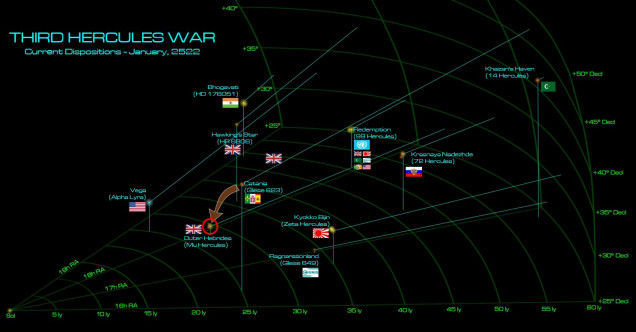 The general situation of the Third Hercules War in the opening months of 2522. Having recently joined the war after a long period of neutrality, the New Roman Alliance has launched this raid out of their Catania colonies in Gliese 623, aimed at British holdings at Mu Hercules. Ironically it’s an American task force that will meet this strike, defending British holdings per military assistance clauses in the recent Treaty of Zubrin.
The general situation of the Third Hercules War in the opening months of 2522. Having recently joined the war after a long period of neutrality, the New Roman Alliance has launched this raid out of their Catania colonies in Gliese 623, aimed at British holdings at Mu Hercules. Ironically it’s an American task force that will meet this strike, defending British holdings per military assistance clauses in the recent Treaty of Zubrin.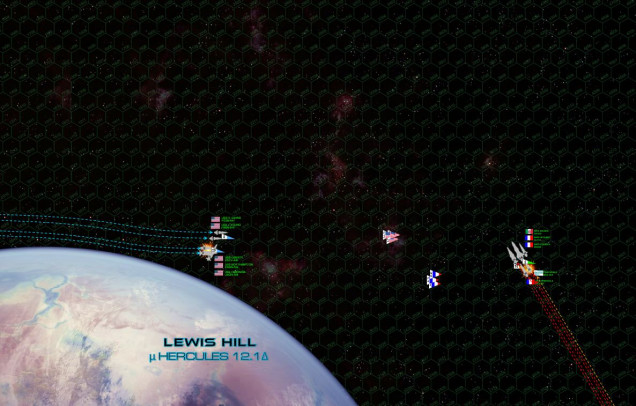 The Americans set a low-angle course, using the gravity if Lewis Hill to dip further behind the New Romans’ port beam, hoping for an angle around their stern. The Americans also seize the “gravity gauge,” the position between their enemies and the planetary body, thus forcing the enemy into the dangerous choice of turning INTO planetary gravity to engage. The Romans, for their part, seize the classic opening position of crossing the Americans “T”, presenting broadsides cross the enemy’s bow. Things start out pretty well for both sides as opening gunnery score major hits at 3300 kilometers, the American destroyer USS Cowpens and Cignis strike frigate CMS Arauz taking heavy damage.
The Americans set a low-angle course, using the gravity if Lewis Hill to dip further behind the New Romans’ port beam, hoping for an angle around their stern. The Americans also seize the “gravity gauge,” the position between their enemies and the planetary body, thus forcing the enemy into the dangerous choice of turning INTO planetary gravity to engage. The Romans, for their part, seize the classic opening position of crossing the Americans “T”, presenting broadsides cross the enemy’s bow. Things start out pretty well for both sides as opening gunnery score major hits at 3300 kilometers, the American destroyer USS Cowpens and Cignis strike frigate CMS Arauz taking heavy damage.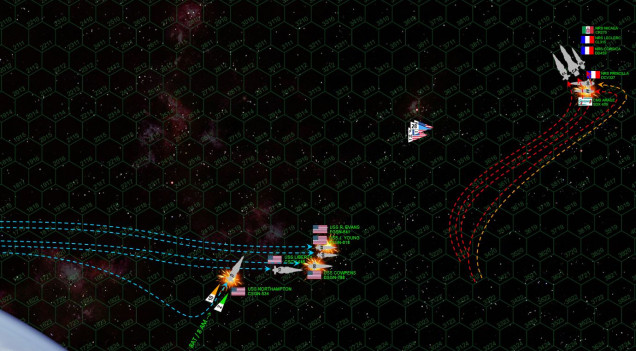 The Americans continue to close at high speed, anxious to get behind the New Roman warships for broadsides across the stern. The New Romans defeat the move, sidestepping at 24 kilometers per second AWAY from the Americans, keeping them within their broadside, refusing to turn into the American’s gravity well and relying on their more accurate guns and heavier firepower to continue to whittle down the American force. For the moment, the Roman plan seems to be working. While the Americans manage to knock the frigate Arauz with a second salvo, their destroyer Cowpens and the frigate USS Ronald Evans are both crippled by withering Franco-Italian lasers and EPCs, and the Americans are still thousands of kilometers away from the sterns of Roman ships. But one factor that the Roman warships can’t outmaneuver is the American aerospace strike group consisting of US Navy squadrons VSF-221 “The Dead Rabbits” and VSA-193 “The Eight Ball Express.” The full fighter and bomber group is finally launched, forming up with a phalanx of Mark 48 gravitic torpedoes for a combined ordinance strike the Americans hope will turn the tide.
The Americans continue to close at high speed, anxious to get behind the New Roman warships for broadsides across the stern. The New Romans defeat the move, sidestepping at 24 kilometers per second AWAY from the Americans, keeping them within their broadside, refusing to turn into the American’s gravity well and relying on their more accurate guns and heavier firepower to continue to whittle down the American force. For the moment, the Roman plan seems to be working. While the Americans manage to knock the frigate Arauz with a second salvo, their destroyer Cowpens and the frigate USS Ronald Evans are both crippled by withering Franco-Italian lasers and EPCs, and the Americans are still thousands of kilometers away from the sterns of Roman ships. But one factor that the Roman warships can’t outmaneuver is the American aerospace strike group consisting of US Navy squadrons VSF-221 “The Dead Rabbits” and VSA-193 “The Eight Ball Express.” The full fighter and bomber group is finally launched, forming up with a phalanx of Mark 48 gravitic torpedoes for a combined ordinance strike the Americans hope will turn the tide.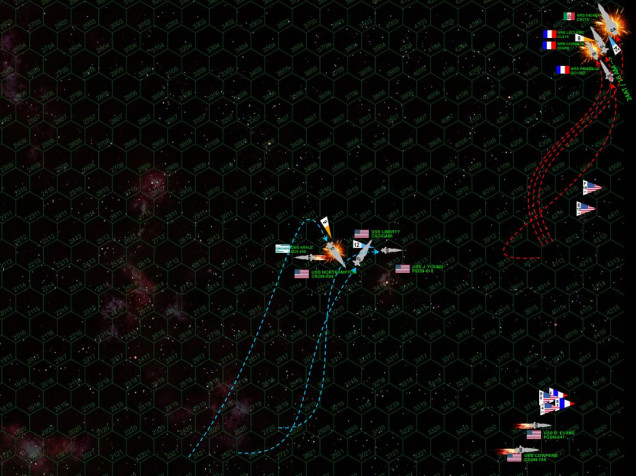 Seconds after the NRS Nicaea’s broadside tears open the port quarter of the light cruiser USS Northampton, the American aerospace and torpedo strike hits the stern of the Roman flagship in turn, not only detonating the ship’s engines and crippling her reactors, but almost blowing the ship up outright. American guns shift fire to the escorting destroyer NRS Corsica (Captain Daphne St. Croix), while the USS Liberty set up for another torpedo spread while also getting close enough to recover her bombers for a possible second strike. The Northampton pivots to present her first proper broadside of the engagement, but already she’s badly hammered by the Nicaea’s previous gunnery.
Seconds after the NRS Nicaea’s broadside tears open the port quarter of the light cruiser USS Northampton, the American aerospace and torpedo strike hits the stern of the Roman flagship in turn, not only detonating the ship’s engines and crippling her reactors, but almost blowing the ship up outright. American guns shift fire to the escorting destroyer NRS Corsica (Captain Daphne St. Croix), while the USS Liberty set up for another torpedo spread while also getting close enough to recover her bombers for a possible second strike. The Northampton pivots to present her first proper broadside of the engagement, but already she’s badly hammered by the Nicaea’s previous gunnery.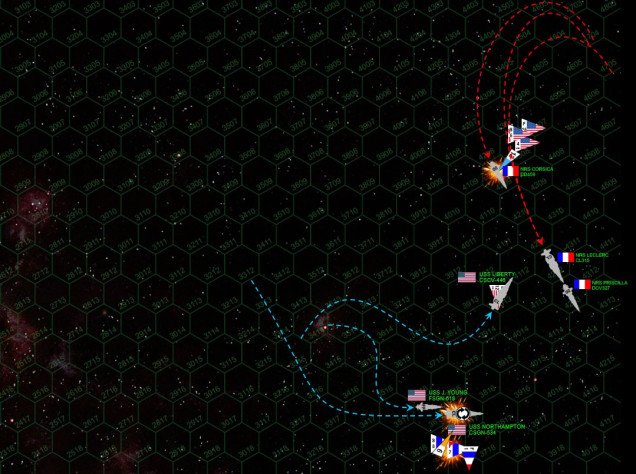 Captain deChalemonde (NRS Leclerc) comes hard about and dives toward the Americans, who are still trying to decelerate after their very fast approach runs. DeChalemonde is also determined to knock out the Northampton (note she is rolled to protect her damaged port side). Roman fighters and torpedoes try to spin around to hit the Northampton’s port quarter (where shields have gone down) but despite losing a fighter, the torpedoes are all shot down and the fighters’ gunnery run doesn’t quite known down the American cruiser. American bombers land to begin rearming for a second torpedo strike, while the Northampton takes another hammering (albeit on a new facing with fresh armor) from the Leclerc and Corsica. The Americans manage to cripple the Corsica, however, while the Liberty also takes tremendous damage along her starboard bow (the French perhaps trying to destroy those “Avenger” torpedo bombers while they’re still in the hangars).
Captain deChalemonde (NRS Leclerc) comes hard about and dives toward the Americans, who are still trying to decelerate after their very fast approach runs. DeChalemonde is also determined to knock out the Northampton (note she is rolled to protect her damaged port side). Roman fighters and torpedoes try to spin around to hit the Northampton’s port quarter (where shields have gone down) but despite losing a fighter, the torpedoes are all shot down and the fighters’ gunnery run doesn’t quite known down the American cruiser. American bombers land to begin rearming for a second torpedo strike, while the Northampton takes another hammering (albeit on a new facing with fresh armor) from the Leclerc and Corsica. The Americans manage to cripple the Corsica, however, while the Liberty also takes tremendous damage along her starboard bow (the French perhaps trying to destroy those “Avenger” torpedo bombers while they’re still in the hangars). 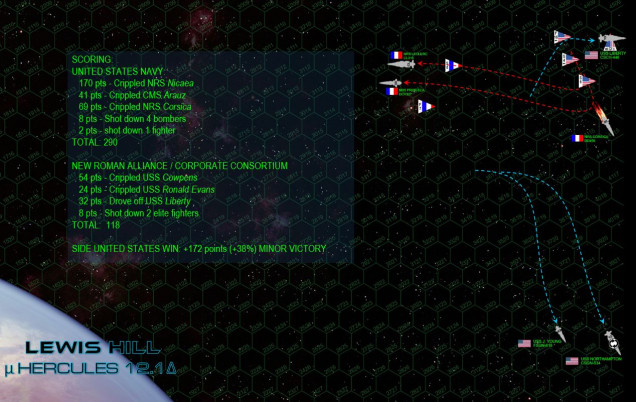 Although the deChalemonde aboard the Leclerc is ready to continue the fight (his light cruiser and the carrier Priscilla remain operational), Captains Zachary Irons aboard the Liberty and Jack Morrison aboard the Northampton accelerate to break off the engagement. That have done far more damage to the Romans than vice-versa, and both the Liberty and Northampton are now very heavily damaged with widespread systems damage. With the frigate USS John Young close abeam, they pull off the Lewis Hill orbital zone and break off the battle, leaving the French over the planetoid but in far, far too weakened a state to maintain a foothold in the Mu Hercules system. The score of the game is displayed in the graphic, shaking out as a VERY solid American minor victory (just two percentage points shy of a major victory). After the embarrassing outcome of Kayashenko 12 and the Treaty of Zubrin, this is a much needed boost to American naval prestige, even if it was won to the benefit of their former British foes. As for the New Romans, it is hardly an auspicious debut into the Third Hercules War, prompting some local archbishops to wonder if perhaps “sitting on the sidelines” was perhaps the best course of action after all.
Although the deChalemonde aboard the Leclerc is ready to continue the fight (his light cruiser and the carrier Priscilla remain operational), Captains Zachary Irons aboard the Liberty and Jack Morrison aboard the Northampton accelerate to break off the engagement. That have done far more damage to the Romans than vice-versa, and both the Liberty and Northampton are now very heavily damaged with widespread systems damage. With the frigate USS John Young close abeam, they pull off the Lewis Hill orbital zone and break off the battle, leaving the French over the planetoid but in far, far too weakened a state to maintain a foothold in the Mu Hercules system. The score of the game is displayed in the graphic, shaking out as a VERY solid American minor victory (just two percentage points shy of a major victory). After the embarrassing outcome of Kayashenko 12 and the Treaty of Zubrin, this is a much needed boost to American naval prestige, even if it was won to the benefit of their former British foes. As for the New Romans, it is hardly an auspicious debut into the Third Hercules War, prompting some local archbishops to wonder if perhaps “sitting on the sidelines” was perhaps the best course of action after all. 









































































Raids are fun! Mean and a little “cowardly”, but totally FUN. It’s good that de Chalemonde got his as kicked his first battle in this war.
Well, he did hold the field in the end, so to speak.
@oriskany So how does it count on the campaign score card as a British win, an American win .. just a new Roman defeat ?
@rasmus – The new campaign chart goes up with the next piece of writing (there were *several* Darkstar games last week). But like we saw with the last campaign chart, the Americans are now in their “neutral” column. Who’s side they’re actually on depends on what star system you’re in. So it counts as an American victory, but not a Coalition of Eagles victory, since the Americans are technically no longer a full member. Definitely counts as a New Roman defeat (Coalition of Eagles defeat). But not a Renkei Alliance victory since the Americans are definitely not a member there,… Read more »